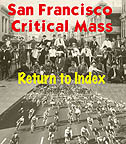
At the 12th San Francisco Critical Mass on August 27, TV finally showed up. Channel 2 did show up once around the third ride or so, but the crew was in a big hurry to go somewhere else. When we refused to ride around in a circle for the cameras they split. I donít think anyone has been doing any press releases to the media. We haven't sought media attention and when it has nosed around we were basically indifferent. Real movements for social change cannot depend on TV news soundbites to communicate!
Elizabeth Weise, an AP reporter and enthusiastic participant, wrote a wire story that went out on Thursday before the ride. CNN and the local Channel 2 10 o'clock News both did very favorable, though typically clipped and superficial, reports. I spoke to both of them and was included in the on-camera coverage in each case. Several of us agreed long ago that media had to come on the ride to get our cooperation, so CNN took my suggestion and came along on the ride, towed by the heroic Kash. The CNN crew apparently shares footage with Channel 2 since some of the same 8mm shots appeared in both segments, but somehow Channel 2 failed to catch the name of the event, and reported it as "The Ride."
Naturally we don't hold this event in order to get on TV, but it was interesting to see again how they soundbite anything you say, even if you know it's coming. My suggestion to the CNN camera that anyone could make copies of their opinions and participate in the Xerocracy was severed from the additional suggestion to use the copiers at work. Perhaps that's not so surprising. TV is definitely not going to encourage direct reappropriation of our collective resources. Moreover, the structure of television news, its ownership and values, make it nearly impossible to see and report on the enormous number of popular grassroots initiatives confronting the results of our ecologically suicidal society. It's been beyond their comprehension until now that a bunch of bicyclists could get together in an "experiment in urban anarchy." (Ch 2). Perhaps the success of a leaderless Critical Mass speaks well for the intense "learning about process" that locals have been doing for years.
TV can't see the deeper connections to sociability and public space in the Critical Mass because it strives to replace human community with itself. Even if a well-meaning TV reporter tried to bring up such deeper issues, she wouldn't have time to discuss it meaningfully before the next commercial! The local news actually showed some compelling footage of the absence of space on the road for bicyclists, but concluded by showing a maniac whizzing up the wrong side of the street against traffic, and said that it was a "two-way street" for cars and bikes to share the road! Brother! Then the anchor asked the live reporter if there had been any response from the authorities, probably fishing for a threatening statement from the police, to which she answered with a confused explanation of how the roads were so crowded and narrow that there wasn't much room for bike paths, unable to imagine any other kind of response by the authorities to this basically good-natured and mellow social gathering. CNN just concluded by holding up a bike helmet and invoking its slang name "skid lids" as a warning.
The fact that Critical Mass has escaped the familiar clichés and forms that have choked oppositional politics really excites me. I have a strong sense of the unpredictability of the outcome of all these accelerated synergies that appear to be going on. I suppose it means something that the idea is spreading to other cities so quickly: now Montreal, Boston, NYC, Poznán Poland, Berkeley CA, Santa Cruz CA, Portland, and it's still jumping along. Completely unrelated but just as impressive are the Tuesday night rides along the coastline in Rio de Janeiro, Brazil by upwards of 7,000 bicyclists a week! Perhaps the Friday will come when the sun is setting on Critical Mass rides for 12 straight hours! And that's an amazing thought if the quality of the rides are anything close to the SF rides in terms of energy, inspiration, connections, etc. Where can it all go? Can a larger vision of social transformation get articulated through this kind of expanded public space/life? Are bikes really subversive, or will we soon see corporate sponsors like Diet Coke in Rio de Janeiro?
— Chris Carlsson, September 1993